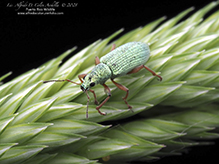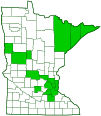pale green weevil
(Polydrusus impressifrons)
Conservation • Description • Habitat • Ecology • Distribution • Taxonomy
|
|
||||||||||||||
Description |
Pale green weevil is an exotic, small, early season, broad-nosed weevil. It is native to western Europe. It was accidentally introduced into North America, probably in nursery stock. The first record of it in North America is from New York in 1913. It has since spread widely. It now occurs across the northern United States and southern Canada. The larvae live in the soil and feed on roots. Adults are active from late May to mid-July. They are found in forests, forest edges, river corridors, urban areas, and plant nurseries. They feed on the leaves and buds of a variety of trees and shrubs. In Minnesota, they have been recorded on 25 species of trees and shrubs; on strawberry, thimbleberry, and raspberry; and on ornamental plants. They are sometimes found in large numbers in nurseries, and they been found on the crops of fruits. However, they are rarely considered pests. Adults are ⅛″ to ¼″ (3.8 to 5.6 mm) in length. The body is elongated-oblong and slender. It is entirely black with a dense covering of iridescent, round, pale scales. The scales are usually green, sometimes bluish green or yellowish green. The head is narrow. The mouthparts are greatly elongated into a snout-like projection of the head (rostrum). The rostrum is short, a little shorter than the head, and broad, slightly narrower than the head. It is deeply pitted (punctate), and it has a deep, broad notch at the tip. The eyes are small and round. They are positioned parallel or almost parallel to the midline of the head. The closest point between the eyes is 1.5 to 2.0 times the width of an eye. The antennae are long, slender, and bent (elbowed). They are attached to the rostrum near the tip. There are 11 antennal segments. The first segment (scape) is slender and very long, reaching far beyond the rear margin of the eye. The last three segments are expanded, forming an elongated-oval club. The groove on the rostrum at the base of each antenna is short, it does not reach the tip of the rostrum. The plate covering the first segment of the thorax (pronotum) is wider than long. It is widest in the middle, the sides are slightly convex, and it is narrowed to the front and to the rear. The surface is finely punctured. The plate between the wing bases (scutellum) is small but distinct. The wing covers (elytra) are more than four times the length of the pronotum, and they are slightly sinuate – very shallowly S-shaped. They are much wider than the pronotum at the base, and they are widest near the tip. Each elytron has several fine longitudinal grooves. The grooves form subtle black lines. The space between the grooves is flat, is finely pitted, and has a single row of very short, reclined bristles. The legs are long, stout, and pale reddish brown. |
Size |
Total length: ⅛″ to ¼″ (3.8 to 5.6 mm) |
Similar Species |
Green immigrant leaf weevil (Polydrusus formosus) is longer and narrower. The body is narrow. The elytra are mostly parallel sided, and they are much less than four times as long as the pronotum. The black grooves on the elytra are much more distinct. The eyes are much larger, and they are positioned at an angle so that the front of the eyes are closer together than the back of the eyes. The distance between the eyes at the front is less than the width of an eye. The scape is much shorter, reaching only to the rear margin of the eyes. The rostrum is not distinctly notched. |
Habitat |
Forests, forest edges, river corridors, urban areas, and plant nurseries |
Ecology |
Season |
One generation per year: late May to mid-July |
Behavior |
|
Life Cycle |
The female lays eggs wherever she can gain access to the wood, either under loose bark or at a tree wound. The larvae overwinter in the soil and pupate in the spring. Adults emerge in late May. |
Larva Food |
Plant roots |
Adult Food |
Leaves and buds of a variety of trees and shrubs |
Distribution |
||
|
Sources |
|
| 2/18/2024 | ||
Occurrence |
||
|
||
Taxonomy |
|
Order |
Coleoptera (Beetles) |
Suborder |
Polyphaga (Water, Rove, Scarab, Long-horned, Leaf, and Snout Beetles) |
Infraorder |
Cucujiformia |
Superfamily |
Curculionoidea (snout and bark beetles) |
Family |
Curculionidae (true weevils) |
Subfamily |
Entiminae (broad-nosed weevils) |
Tribe |
Polydrusini |
Genus |
Polydrusus |
Subgenus |
Eustolus |
Subordinate Taxa |
|
pale green weevil (Polydrusus impressifrons danieli) pale green weevil (Polydrusus impressifrons impressifrons) |
|
Synonyms |
|
|
|
Common Names |
|
pale green weevil |
|
Glossary
Elytra
The hardened or leathery forewings of beetles used to protect the fragile hindwings, which are used for flying. Singular: elytron.
Pronotum
The exoskeletal plate on the upper side of the first segment of the thorax of an insect.
Punctate
Dotted with pits (punctures), translucent sunken glands, or colored spots of pigment.
Rostrum
The stiff, beak-like projection of the carapace or prolongation of the head of an insect, crustacean, or cetacean.
Scape
In plants: An erect, leafless stalk growing from the rootstock and supporting a flower or a flower cluster. In insects: The basal segment of the antenna.
Scutellum
The exoskeletal plate covering the rearward (posterior) part of the middle segment of the thorax in some insects. In Coleoptera, Hemiptera, and Homoptera, the dorsal, often triangular plate behind the pronotum and between the bases of the front wings. In Diptera, the exoskeletal plate between the abdomen and the thorax.
Visitor Photos |
||
Share your photo of this insect. |
||
This button not working for you? |
||
Alfredo Colon |
||
 |
||
MinnesotaSeasons.com Photos |
||
|
||
|
||

Slideshows |
|

Visitor Videos |
||
Share your video of this insect. |
||
This button not working for you? |
||
|
Other Videos |
||
Broad-nosed Weevil (Curculionidae: Polydrusus impressifrons) on Thumb |
About
Jun 28, 2011 Gracious me! The videographer could use a manicure! ;- o Photographed at Fisher, Minnesota (28 June 2011). |
Charançon vert pâle/Pale Green Weevil (Polydrusus impressifrons) |
About
Feb 10, 2022 Découvrez les insectes du Québec. / explorationnature |

Created: Last Updated: © MinnesotaSeasons.com. All rights reserved. |




